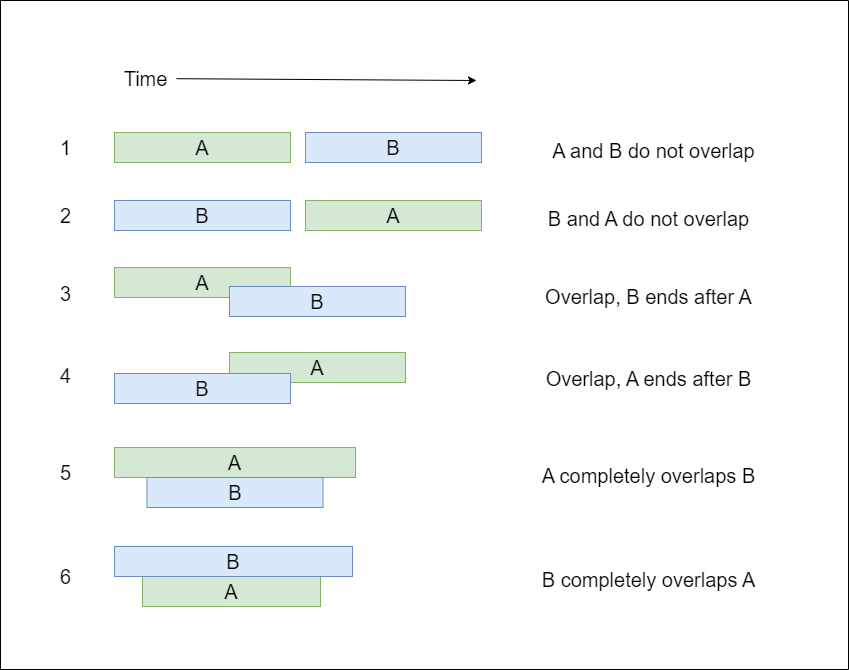DSA: Intervals
- Tandid Alam
- Nov 28, 2022
- 1 min read
Fundamentals of Intervals
What to Look Out For
Corner Cases
Common Techniques
Practice Problems
Learning Resources
Fundamentals of Intervals
Interval questions are a subset of array questions where you are given an array of two-element arrays (an interval) and the two values represent a start and an end value. Interval questions are considered part of the array family but they involve some common techniques hence they are extracted out to this special section of their own.
An example interval array: [[1, 2], [4, 7]].
Given two intervals (‘A’ and ‘B’), there will be six different ways the two intervals can relate to each other:

What to Look Out For
Clarify with the interviewer whether [1, 2] and [2, 3] are considered overlapping intervals as it affects how you will write your equality checks.
Clarify whether an interval of [a, b] will strictly follow a < b (a is smaller than b)
Corner Cases
No intervals
Single interval
Two intervals
Non-overlapping intervals
An interval totally consumed within another interval
Duplicate intervals (exactly the same start and end)
Intervals which start right where another interval ends - [[1, 2], [2, 3]]
Common Techniques
Sort Intervals
Typically, you want to sort the intervals by their starting point.
#sort method
intervals.sort()
#sorted method with lambda
sorted_intervals = sorted(intervals, key=lambda x : x[0])Check if Intervals Overlap:
def is_overlap(a, b):
return not(a[1] < b[0] or b[1] < a[0])Merge Two Intervals:
def merge_overlapping_intervals(a, b):
return [min(a[0], b[0]), max(a[1], b[1])] Readable Code:
It's a lot easier to read code regarding intervals if you create start and end variables rather than using 0 and 1.
interval = [2, 5]
start, end = 0, 1
interval[start] # 2
interval[end] # 5Practice Problems
Merge Intervals
def mergeIntervals(intervals):
intervals.sort() # Sort the intervals
start, end = 0, 1
result = []
def overlap(a, b): #Define a function to find overlaps
return not(a[1] < b[0] or b[1] < a[0])
for interval in intervals:
# If no result or no overlaps, append interval
if len(result) == 0 or not overlap(result[-1], interval):
result.append(interval)
else:
result[-1][end] = max(result[-1][end], interval[end])
return resultInsert Interval
def insert(intervals, newInterval):
result = []
i, start, end = 0, 0, 1
#skip and add to output all intervals that come before the new
interval
while i < len(intervals) and
intervals[i][end] < newInterval[start]:
result.append(intervals[i])
i += 1
#merge all intervals that overlap with the new interval
while i < len(intervals) and
intervals[i][start] <= newInterval[end]:
newInterval[start] =
min(intervals[i][start], newInterval[start])
newInterval[end] =
max(intervals[i][end], newInterval[end])
i += 1
#insert new interval
result.append(newInterval)
#add all the remaining intervals
while i < len(intervals):
result.append(intervals[i])
i += 1
return result
Meeting Rooms
def canAttendMeetings(intervals):
intervals.sort()
for i in range(len(intervals) - 1):
if intervals[i][1] > intervals[i + 1][0]:
return False
return TrueMeeting Rooms II
def minMeetingRooms(intervals):
#Create arr of start vals and end vals
start = sorted([i[0] for i in intervals])
end = sorted([i[1] for i in intervals])
result, count = 0, 0
#Use pointers to traverse through arrays
sPointer, ePointer = 0, 0
while sPointer < len(intervals):
#increment count if startVal < endVal
if start[sPointer] < end[ePointer]:
count += 1
sPointer += 1
else: # decrement count if startVal >= endVal
count -=1
ePointer +=1
result = max(result, count)
return result


Comments